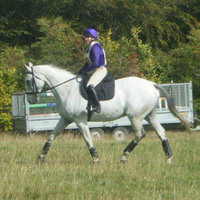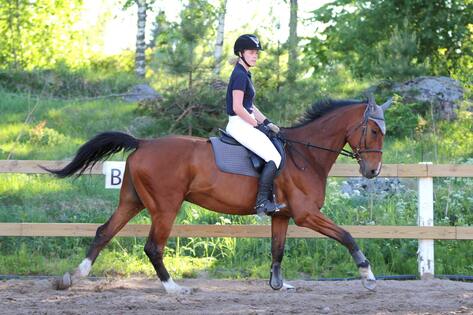Going to a dressage competition can be stressful, especially if you’ve never been to one before or haven’t competed for a long period of time, but there’s plenty you can do in advance to ensure you’re as well prepared as possible.
The first is to familiarise yourself with the rules. Most unaffiliated dressage competitions use the British Dressage rule book - here’s our quick guide to tack, equipment and wardrobe for you and your horse (the full rule book can be accessed online
here).
We've broken this guide down into sections to make prepping for your next dressage competition just that little bit easier! Take a read through to familiarise yourself with all elements of dressage, or click through to the section you're most interested in below:
Dressage is the most conservative of the disciplines, so I’m afraid you’ll need to put away your coloured hat covers, jodphurs/breeches, shirts and jackets.
Hats:
Your hat must meet the standard PAS 015. You'll know that your hat meets this standard if you can look at the inside of it and see the Kitemark logo - like below.

Jackets:
Show jackets or tweed jackets are best. In warmer weather, you may be able to ride in a shirt with short sleeves that cover your shoulders.
Breeches/Jodphurs:
These are most commonly worn in the colours white, creame, beige or canary yellow.
Shirts:
Suitable shirts can have long or short sleeves with a white collar. Typically, they should be fastened at the neck with a tie, stock in a solid plain colour or a white round collar.
Gloves:
Gloves must be worn, usually in muted colours.
Boots:
Riding boots or short boots with or without gaiters or chaps of the same leather and colour of the boots.

Bridles:
Anatomical/Padded combination/Ergonomic Micklem (no clips). A bit must be used, and you could find a full list of permitted bits here.
Nosebands:
Drop/grackle/flash/cavesson
Saddle:
Dressage of GP (General Purpose). No treeless saddles.
Stirrups:
Any colour but no magnetic stirrups or velcro straps attached to the girth.
Numnah/Saddle Cloth:
Predominantly white, cream or a conservative colour.
Other Equipment:
There are other permitted equipment options such as Fly veils, Nose nets, Neck straps, Breastplates or Breast girths.
All horses must wear numbers visible on both sides either on the bridle or the saddle cloth. This means you will need two numbers, one for each side of the bridle or saddle cloth. You may carry a whip for both the warm-up and the test. Unfortunately, hoof boots are not allowed and leg boots or bandages are only permitted in the warm-up.
If you are concerned about remembering the test you’re allowed to have a caller, choose someone with a loud, clear voice who has familiarised themselves with the test. It is an art calling out the movements in time for you to prepare whilst not getting too far ahead you forget what’s next! The caller is only allowed to read out the movements of the test and not give you any other information or encouragement so make sure they’re aware of this.
If your horse isn’t used to competing in dressage competitions they can be a bit phased by the whiteboards and letter markers so see if you can find some way of practicing riding inside poles and blocks to simulate this. The other thing to bear in mind is that once the judge has rung the bell you have 45 seconds to enter the arena and begin your test. At home, practice trotting around your arena or field for 35-40 seconds until you know what that feels like and therefore won’t feel rushed on the day of the competition.

Make sure you check when your times will be available and once you have them work out how long you will need to get to the venue – I usually allow time and a half, e.g. if it takes me 30 minutes in the car, I allow 45 minutes in the lorry or trailer. How long do you need to get your bearings when you arrive, how long to tack up and get ready, and how long to warm up?
One of the first things to do (after the loo of course!) is to visit the secretary to declare and check if all is running on time. Familiarise yourself with the arena you will be doing your test in, where the warm-up is, and if there are any restrictions on numbers in the warm-up. Always a good idea to make yourself known to the steward either before you get on or as you enter the warm-up arena.
Last but not least - try to have fun!



